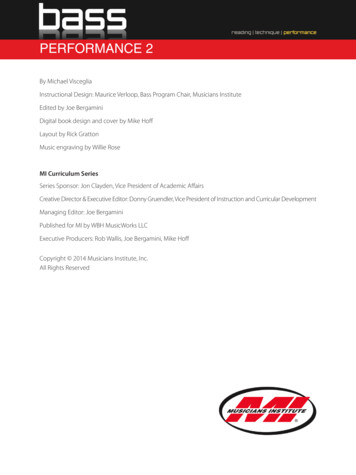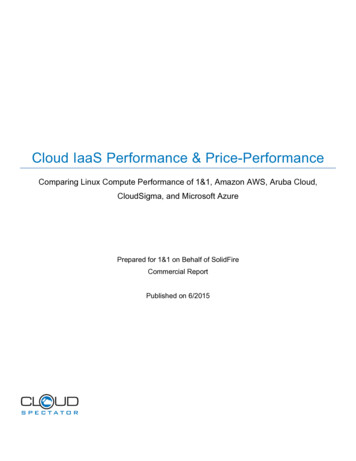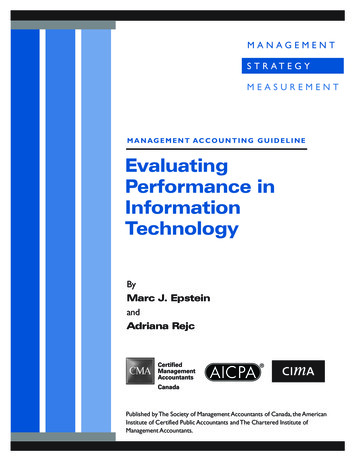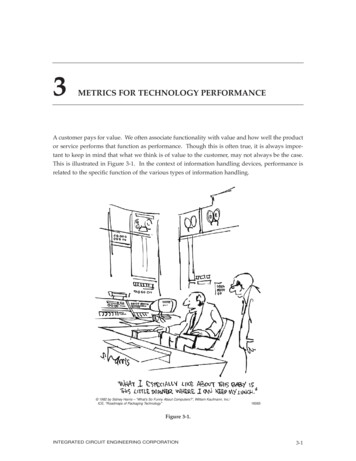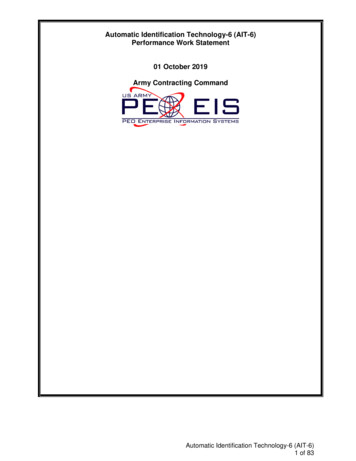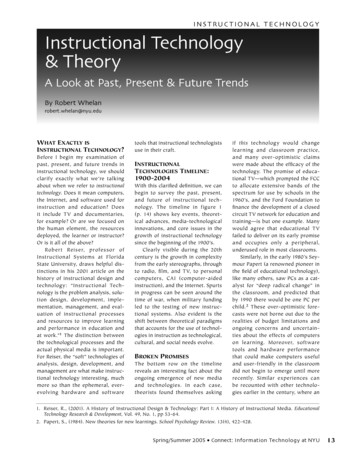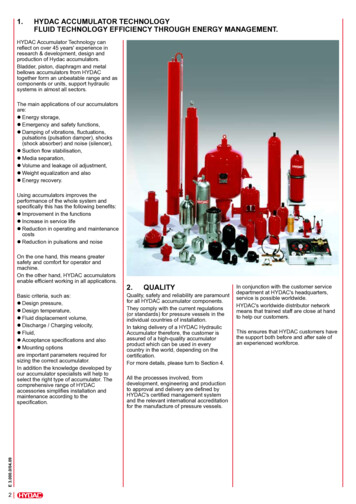
Transcription
2015 Proceedings of the Conference on Information Systems Applied ResearchWilmington, North Carolina USAISSN: 2167-1508v8 n3653The Technology-to-Performance Chain:Conceptualizing How Lead Management SystemsDrive Inside Sales PerformanceAlhassan Ohiomahaohio100@uOttawa.caMorad Benyoucefbenyoucef@Telfer.uOttawa.caPavel Andreevandreev@Telfer.uOttawa.caTelfer School of ManagementUniversity of OttawaOttawa, ON K1N 6N5, CanadaAbstractInside sales are remote sales that are performed using different communication technologies. Sincethere is no traditional face-to-face interaction between the salesperson and the lead (i.e., the potentialcustomer), it is vital that the leads, which are costly to obtain, are managed properly. Leadsmanagement is usually operationalized using information technology tools called lead managementsystems. There is a need to understand the impact of lead management systems on inside salesperformance as well as to identify key drivers and enablers of inside sales performance. This researchdevelops a conceptual model to investigate the impact of lead management systems on inside salesperformance through mediating mechanisms of task characteristics (call productivity and lead followup), selling behaviour (adaptive selling) and salesperson characteristics (salesperson’s competency).The findings of this research contributes to the inside sales literature, and educates practitioners in theinside sales industry on sales technology approaches and factors that enhance sales performance.Keywords: Inside Sales, Lead Management Systems, Sales Performance, Conceptual Model.1. INTRODUCTIONThere is currently a shortage of research studieson inside sales in general, and in particularly onsales-technology approaches to the inside salesprocess that can help shape future developmentdecisions and enhance sales performance.Despite the fact that the field of inside sales isknown to be an early adopter of CustomerRelationship Management (CRM) technology,little has been done to study it (Dickie & Trailer,2006). The term “inside sales” is defined asremote sales or professional sales done remotely(Krogue, 2013). They enable individuals orgroups to advocate for their products andservices to prospective customers via thetelephone or the Internet rather than viatraditional in-person interaction (Seley &Holloway, 2008). In contrast, outside sales (akafield sales) refer to the selling of products andservices away from a company’s place ofbusiness, usually at a customer’s place ofbusiness or their home. Most inside sales areconductedinbusiness-to-business(B2B) 2015 ISCAP (Information Systems & Computing Academic Professionals)http://iscap.infoPage 1
2015 Proceedings of the Conference on Information Systems Applied ResearchWilmington, North Carolina USAISSN: 2167-1508v8 n3653environments (Davis, 2013; Krogue, 2013). Thefact that this is a rapidly evolving trend in thebusiness world means that it requires in-depthexploration. A trends study conducted in 2009found that inside sales were consistentlygrowing as an industry (Oldroyd, 2009), and in2013 the growth rate of inside sales was foundto be 5% greater than that of outside sales(Warner, 2013).A crucial success factor in any inside salessetting is the efficacy with which leads andcontacts are managed. A lead is a documentedinterest in an organization’s product or service,irrespective of whether that interest is from anew prospect or from an existing customer(Monat, 2011). A lead usually contains the basicinformation a salesperson needs to make thatfirst contact with a potential customer (Griggs,1997). Lead management incorporates a set oforganized processes and procedures to makecertain that all generated and qualified leads arepursued by sales.The diligent follow-up of sales leads is a crucialpart of the customer-acquisition process in B2Bfirms (Sabnis, Chatterjee, Grewal, & Lilien,2013). B2B organizations spend an estimated 30 to 200 on each marketing lead generated,while B2C (business-to-consumer) organizationsspend an estimated 2 to 25 per leadgenerated through advertising, web hstanding the substantial investmentsthat are made, statistics show that the majorityof these leads are ignored and never contacted(Griggs, 1997; MarketingSherpa, 2011 )because of a poor work ethic among salespersonnel (Sabnis et al., 2013) and because ofinefficient lead management systems (Griggs,1997; Vanillasoft, 2014). Well-organized leadmanagement is an important part of marketingeffectiveness. Failure to efficiently manage leadsdiminishes sales results and increases costs,which ultimately hinders the ability of sales andmarketing programs to achieve financial andorganizational objectives. Nevertheless, fewacademic studies have attempted to researchthe best lead management practices in order toaddress this problem and thereby improve thecustomer-acquisitionprocess(Elkington&Oldroyd, 2007; Sabnis et al., 2013).Technology plays a vital role in inside sales butmany inside sales programs fail to achieve theirgoals because of the inefficiencies introduced bytechnologies that support the inside salesfunction (Marketo, 2008). It is evident that notmuch effort has been made to study howtechnology supports inside sales. Most studieshave focused on the outside sales domain. Thereis a need to understand how technology is usedin inside sales and how it supports their process.Most importantly, no study has yet addressedthe role of lead management systems andspecifically how well organized practices withinlead management can help to drive salesperformance in the inside sales industry. We seea strong potential in addressing the challengesfaced by sales organizations in terms of leadmanagement by means of carefully designedlead management systems. The processes andsystems involved in resourcefully managingthese leads are prerequisites for sales success,hence we need lead management systems builton best practices.In this research, we look at the practices thatenable information systems to leverage andstrengthen key aspects of sales performance inthe inside sales industry. We focus on theconsequences of lead management systemsusage by developing a conceptual model toexplore their impact of key drivers and inhibitorson sales performance. In order to achieve thisobjective, we seek to answer the followingquestions:1. What are the drivers and enablers ofinside sales performance?2. How does the use of lead he rest of this paper is organized as follows.First, we review the theoretical background andrelated work on Information Technology (IT)impacts on sales performance. We then detailour hypotheses, and develop a conceptual modelto explore lead management systems’ impactson inside sales performance. Finally, we discussthe theoretical and practical implications of ourresearch.2. THEORETICAL BACKGROUNDNumerous studies have acknowledged g.,Ahearne,Hughes,&Schillewaert, 2007; Ahearne, Jones, Rapp, &Mathieu, 2008; Hunter & Perreault Jr, 2006;Rapp, Beitelspacher, Schillewaert, & Baker, 2015 ISCAP (Information Systems & Computing Academic Professionals)http://iscap.infoPage 2
2015 Proceedings of the Conference on Information Systems Applied ResearchWilmington, North Carolina USAISSN: 2167-1508v8 n36532012). For instance, the impact of IT on salesperformance can be seen through the TaskTechnology-Fit (TTF) theory by Goodhue andThompson (1995). This theory claims thatindividuals’ use of IT affects their performanceand that the performance benefits will begreater if the IT fits the task (Goodhue &Thompson, 1995).While some studies extending the TTF theory insales have been conducted, they have mostlyfocused on outside sales. Ahearne, Hughes, &Schillewaert (2007) suggest that IT influencessales performane through mediating processesof knowledge, call productivity, presentation andtargeting skills. Rapp, Agnihotri, and Forbes(2008) argue that IT use for analytical purposes(i.e., CRM) positively influences adaptive selling,and that IT use for operational purposes (i.e.,SFA) reduces the number of hours worked bysalespeople (Effort). Ultimately, both adaptiveselling and effort influence sales performance.Ahearne et al. (2008) advocate that IT does notinfluence performance directly but ratherthrough a variety of mediating factors, namelyselling behaviour (customer service), andsalesperson characteristics (adaptability), whichare demonstrated during salesperson-customerexchanges. Relatedly, Park, Kim, Dubinsky, &Lee (2011) suggest that SFA usage influencesperformance through adaptive selling, marketinginformation processing and relationship quality.None of the models introduced by these studiescan fully be applied to an inside sales domainbecause they all lack one or more variablesimportant for completing the inside sales task oflead management. The literature calls for anextension on the TTF theory to develop atechnology-to-performance chain model forinside sales. The TTF theory emphasizes the use1.1of technology to achieve distinctive strategicgoals (Goodhue & Thompson, 1995). Thus, weextend this theory to help understand how theuse of technology (i.e., Lead managementsystems) to effectively support the leadmanagement task influences performance in theinside sales industry.To begin with, it is important that we identifyand categorize, from the literature, the driversof inside sales performance, and subsequentlypinpoint those that are crucial for achieving thelead management objectives. Weitz (1981)suggests that a salesperson’s performance isimpacted by their selling behaviour (i.e.,adaptive selling), which is moderated by asalesperson’s characteristics (i.e., knowledge,motivation, skills, etc.), selling relationshipcharacteristics and task characteristics. ChurchillJr, Ford, Hartley, and Walker Jr (1985) proposesix elements that determine the performance ofa salesperson and ultimately sales performance:role variables, skill, motivation, personal factors,aptitude, and organizational or environmentalfactors. Weitz, Sujan, and Sujan (1986) arguethat sales management variables (i.e., sellingenvironment), salesperson characteristics andsalesperson behaviour determine a salesperson'sperformance. Kohli (1989) propose that asalesperson’s performance is impacted byvariables that can be grouped in threecategories: salesperson’s characteristics and roleperception, task characteristics, and supervisorybehaviours. Finally, Verbeke, Dietz, and Verwaal(2011) identified five elements to predict salesperformance, namely selling-related knowledge,adaptive selling, role ambiguity, aptitude, andwork engagement.To better assess the relationship between IT andsales performance, we base our arguments onthe technology-to-performance chain (TCP)model (Goodhue & Thompson, 1995 p.217) ofthe TTF theory. Furthermore, and based on ourdiscussionhighlightingthefactorsthatdetermine sales performance, we classify theimpact of lead management systems’ usage onsales performance via the following mediators:(1) task characteristics, (2) selling behaviour,and (3) salesperson’s characteristics. Thesemediatorsreflectthebenefitsofleadmanagement systems, plus they have beenacknowledgedintheliteratureaskeydeterminants of sales performance (e.g., Weitz,1981). These are briefly discussed below.Task CharacteristicsTasks are activities performed by individuals toachieve outputs (Goodhue & Thompson, 1995).Studies have evaluated salespeople’s tasks bymeasuring the effort a salesperson devotes toachieving sales objectives. Such effort ismeasured by the number of sales calls over thetotal time invested by the salesperson (Rapp etal.,2008;Rapp,Ahearne,Mathieu,&Schillewaert, 2006; Sujan, Weitz, & Kumar,1994), the persistency devoted to work, andcontinuing to try in the face of failures (Sujan etal., 1994). An important representation ofsalespeople’s efforts to realize their objectives isthe activity through which they complete theirtasks (Brown & Peterson, 1994; Rapp et al.,2008). In our research, the basic activities 2015 ISCAP (Information Systems & Computing Academic Professionals)http://iscap.infoPage 3
2015 Proceedings of the Conference on Information Systems Applied ResearchWilmington, North Carolina USAISSN: 2167-1508v8 n3653associated with achieving lead managementtasks include identifying profitable leads, makingcalls to leads and following-up on leads withcalls, voicemails and emails. Hence, wecharacterize a salesperson’s effort on leadmanagement into call productivity and leadfollow-up.Selling BehaviourPlank and Reid (1994) defined selling behaviouras the strategy people use during the mance of their jobs. Two sellingbehaviours (adaptive and customer-oriented)have been investigated in the sales forceresearch stream (Chakrabarty, Widing, & Brown,2014; Franke & Park, 2006). The correlationbetween customer-oriented selling and salesperformance is highly dependent upon long termbuyer-seller relationship (Chakrabarty et al.,2014; Saxe & Weitz, 1982). However, given thatour research is related to a short term customeracquisition activity (i.e., lead management), itmay be difficult to obtain applicable data thatcan justify the relationship between the twovariables, and hence, our research will notconsider customer-oriented selling. Adaptiveselling on the other hand is important in aidingthe performance of the lead managementprocess.Salesperson enconceptualizedasacombinationofasalesperson’s selling-related knowledge, e et al., 2008; Churchill Jr et al., 1985;Verbeke et al., 2011). We believe that acombination of these factors reflects a“salesperson’s competency”, competency beinga cluster of related knowledge, attitudes, andskills of a person, resulting in effective and/orsuperior performance (Lambert, 2009; Richard,1982).Sales PerformanceThe discipline of sales has a long history ofresearch on performance. Sales performance isthe realized outcome from executing tasks,which may differ greatly across different types ofselling jobs and situations (Walker, Churchill, &Ford, 1979). In earlier times, dollar or salesvolume was the insightful way to conceptualizesales performance (Barker, 1999). However,with the growing significance of customersatisfaction, loyalty, customer knowledge andother crucial customer interaction aspects(Zallocco, Pullins, & Mallin, 2009), diverseconceptsforsalesperformancewereestablished. Behrman and Perreault Jr (1982)suggest that producing high market share,selling products with highest profit margins,quickly generating sales of new products,generating high levels of dollar sales, producingsales with long-term profitability, selling tomajor accounts, and exceeding annual salesobjectives are significant reflections of salesperformance. Anderson and Oliver (1987) seesales performance as the evaluation ofsalespeople based on outcomes (e.g., revenue)and behavioural (e.g., salesperson competence)performance. Zallocco et al. (2009) synthesisedprevious studies and grouped sales performanceinto performance effectiveness and performanceefficiency. They describe efficiency as the ratioof selling output (close ratios) to selling input(sales calls), and effectiveness as a dbehaviours to valued organizational outcomes.CallProductivityH7H1LeadFollow-UpH8H2Use of LMSSalesPerformanceH63. CONCEPTUAL MODEL DEVELOPMENTH9Based on the above, we propose a model (Figure1) exploring the impact of lead managementsystems’ usage on inside sales performance viathe mediators selling behaviour (adaptiveselling), task characteristics (call eristics (Salesperson’s competency). Thefollowing discussion explains the development ofthe concepts used in this lingFigure 1: Conceptual Model 2015 ISCAP (Information Systems & Computing Academic Professionals)http://iscap.infoPage 4
2015 Proceedings of the Conference on Information Systems Applied ResearchWilmington, North Carolina USAISSN: 2167-1508v8 n3653We define sales performance as the degree ofefficiency and effectiveness to which asalesperson achieves the objectives of leadmanagement for an inside sales organization.Most inside sales organizations set numericgoals for their salespeople to accomplish withina specified time period. The nature of the goal tobe achieved varies from an organization to thenext. Typically, it can be revenue or salesvolumebased.Forsomeinsidesalesorganizations, it might be measured by thenumber of call dials advocated by a salesperson.Call ProductivityFor inside sales organizations, a call is aninstance of speaking to a lead or attempting tocontact a lead through the phone or Internettechnologies with the intention of selling aproduct or service. Productivity (output overinput) is the key measure of a salesperson’scalling activity (Ahearne et al., 2007; Sujan etal., 1994) and is not limited to making lots ofcalls but making quality calls that could yieldsales. As reported in Vanillasoft (2014) , mostsalespeople often dial to hit their daily callquota. We define sales call productivity as thenumber of sales calls made by a salespersonover the number of hours as well as the ratio ofsuccessful call connects. In general, theachievement of lead management activitiesinfluences sales performance. Improved salescall productivity has been known to impact salesperformance (Ahearne et al., 2007; Rapp et al.,2012; Zallocco et al., 2009). We posit that:Hypothesis 1: Sales call productivity positivelyaffects sales performanceLead Follow-upSabnis et al. (2013) described lead follow-up ascustomer acquisition efforts on generated leads.It is the ability of a salesperson to closely pursueleads and to maintain contact with these leadsuntil the close of sales or a lead is abandoned.Every lead is a potential sale, so salespeopleneed to work on every lead with persistency andspeed (Elkington & Oldroyd, 2007). The earlier alead is contacted after an enquiry, the morechances there are of converting it into a sale.Response time impacts lead qualification andultimately sales. Prospects usually develop ahigh perception of an organization’s product orservice when salespeople quickly contact themafter an inquiry. Lead follow-up increasesconversion ratio, and improved lead conversionratio is a core indicator of enhanced salesperformance. It also helps organizations torealize the full benefits of their marketingprograms and reduce the number of leads thatgo to waste. We posit that:Hypothesis 2: Lead follow-up positively affectssales performanceAdaptive SellingThis strategic selling approach involves the“altering of selling behaviours during a customerinteraction or across customer interactionsbased on perceived information about the natureof the selling situation” (Weitz et al., 1986).Adaptive selling is measured by the ease andflexibility with which salespeople change theirselling styles while making sales (e.g., does asalesperson vary his/her selling style fromcustomer to customer?).Salespeople can use information gathered fromcustomers to increase sales value and profits(Hughes, Le Bon, & Rapp, 2013) by modifyingsales presentations strategies to fit individualcustomers' needs and preferences (Franke &Park, 2006) for the purpose of improving thelikelihood of making a sale (Giacobbe, JacksonJr, Crosby, & Bridges, 2006). The basis foradaptive selling behaviour comes from the factthat there is no single best way to sell, andtherefore a good salesperson should be able toselect, alter and implement a sales strategybased on the characteristics of the prospectivecustomer and selling situation (Román &Iacobucci, 2010).The sales and marketing literature providesgeneral support for the relationship bet
1997; Vanillasoft, 2014). Well-organized lead management is an important part of marketing effectiveness. Failure to efficiently manage leads diminishes sales results and increases costs, which ultimately hinders the ability of sales and marketing programs to achieve f


